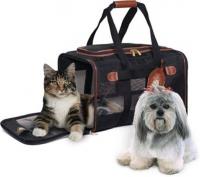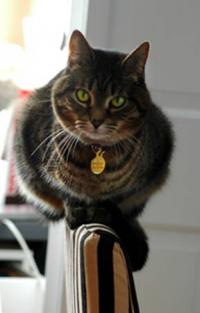Pet Friendly Travel
You know you love to travel with your pet. Dogs often love car rides and eagerly jump in ready to go. There are some, however, who either have motion sickness or are afraid of the car. A cat car ride doesn't always go as smoothly though! Cats routinely don’t like cars unless you get them used to traveling.
Motion Sickness
Motion sickness can make pet friendly travel difficult to say the least. It is a reaction to the movement of the vehicle. Some pets, especially cats, have similar signs, but it can be due to anxiety and not motion. Anti-nausea medicine will still help these pets feel better, though you need to work on the anxiety as well.
Pets with motion sickness often don’t move much and tend to drool. They may vomit as well. Diarrhea is not usually a symptom of motion sickness but can be a result of anxiety.Many youngsters have problems with motion sickness when you first start taking them in a car. Most will grow out of it, but some adults continue to have problems. Treating the motion sickness is often all you need to do so they will like the car.
There are many prescription and over the counter medications, including anti-emetics and tranquilizers, available that can help with the nausea from motion sickness. Some can even relax your pet for the ride. Talk to your vet about which one is best for your pet.
You can try herbs instead. Ginger is well known for combating motion sickness. Give 1 capsule (550mg) of ginger root for every 20-30 pounds of body weight. For smaller pets you’ll need to give a part of the capsule mixed with food. However, some pets won’t eat it due to the pungent odor. Too much of it will actually cause nausea, especially if given on an empty stomach. Repeat it in 8-12 hours if needed.
Slippery elm bark will often help for vomiting and diarrhea. It is especially helpful for problems due to anxiety and stress. Pets take it readily so it may be the easiest product to give, especially to cats. Give 1 capsule (400 mg) for every 15 lbs. of body weight.
Give all of these products 30-60 minutes before the car ride to help ensure pet friendly travel.
Getting Used to the Car
Now that you have any motion sickness under control, before you travel with your pet, let’s make sure your pet is comfortable with car rides. Some dogs are more comfortable in their crate, while others like being out. Whichever your dog prefers, make sure you look into options to keep them safely restrained in the vehicle, such as high safety rated doggie harness seatbelts. Once your pet is comfortable with the crate or carrier in the house, you can proceed to the car.
Cat car safety tip- Cats will always need to be in a carrier.
Feed your pet meals or treats while in the car and not moving. You can give them a food toy stuffed with their favorite. Once your pet is comfortable with this, turn the car on and gauge your pet’s reaction. You don’t want to do anything that triggers anxiety.
Once your pet is OK with the car running, back the car up a short distance, drive forward and turn the car off. Do this several times over a few days. Then go for a short ride around the block. As your pet becomes more used to a car ride, you can travel with your pet for longer distances.
It helps if you can go somewhere fun with your pet. This is easy for dogs as you can take them to a park or to a friend’s house. Since most cats don’t like going to different places, your best bet is to just get your cat to enjoy the car ride for itself. Providing lots of treats definitely helps ensure pet friendly travel!
You want to avoid taking your pet for a car ride only to go to the vet. That will add to your pet’s anxiety unless your pet is one of those adorable patients that loves to see the vet!
When starting this process, it’s important to remember to stop the car before your pet shows any signs of anxiety. Go slowly.
Treating Anxiety
If you need to travel with your pet who hates the car and you don’t have time to get him used to it, you can use some things that help with anxiety. You may need to try different ones to see what works best for your pet or use a combination for pet friendly travel.
- Pheromones (chemicals specific to each type of animal) will often have calming effects. Feliway® is for cats and Adaptil or D.A.P.® is for dogs.
- Lavender is calming and may be slightly sedating. Put some lavender oil on a cotton ball and wipe the door of the carrier with it or dab some in a spot in the car. Don’t put it where your pet can lick it because the oil is toxic if eaten. It needn’t be strong smelling to work. If it’s too strong, your driver may get drowsy!
- Composure™ by Vetri-Science and Anxitane® are calming for some pets.
- Valerian is an herb that can calm your pet and make him sleepy. Give 100 mg of the dried herb for every 10 lbs. of body weight. (The concentrated extract has a different dose.) Repeat in 8-12 hours if needed. The herb smells like dirty socks, so if it stinks it’s probably good!
- ThunderShirt or similar products can help some pets. The shirt wraps around your pet and the pressure on the body has a calming effect.
Dog and Cat Car Safety
When you travel with your pet, all pets need to be restrained while in a car. That means in a carrier secured inside the car or with a pet seat belt/harness. Unfortunately, testing by the Center for Pet Safety found that none of the current products on the market will protect your pet completely. The Center is currently creating standards for products that will provide complete dog and cat car protection.
Until that time, it’s still a good idea to use something. It will at least slow down your pet in a collision. It may also prevent your pet from being thrown into you.
If your pet is in the front seat (restrained of course!), deactivate the passenger airbag. Put a blanket down on leather or vinyl seats to give your dog better footing. Feeling more secure will help provide for pet friendly travel.
Travel with Your Pet on Long Trips
If you are taking your pet on a long trip, take water and a bowl with you. Pet friendly travel always involves plenty of breaks for food, water, and to go potty. Cats will usually not use a litter box while traveling. However, you should offer a box to your cat if you are on the road for many hours and you can do it safely. Most pets, unless they are very young or small, won’t need to eat during the trip.
Cat Car Tip- get a smaller box than what you keep at home, it will be easier to transport. You could even consider getting a disposable box to travel with your pet!
If your pet is on any medications or a special diet, take a list of them along with enough to last. Be sure your pet is up to date on vaccinations before traveling.
Carry a copy of your pet’s rabies certificate with you. You should also ask your vet about getting a USDA APHIS approved Interstate Travel Pet Health Certificate if crossing state lines. Include the name and number of your veterinarian in your papers. Have your pet microchipped and register directly with the microchip company with your cell phone number. Your pet should also wear a tag with your number.
Loud Noises
Some pets will develop a fear of the car because of loud noises they have encountered. If this is the case, you may need to help your pet get used to noises. Melatonin will help some pets with thunderstorm fears and other noise phobias. Give 1 mg. for every 20 lbs. of body weight up to three times daily.
For more information on how to help your pet with Overcoming Noise Phobia, check out this article.
Summary
Most pets can learn to be comfortable on car rides, though it may take some time and effort on your part. It’s worth the effort; less stress for you and them in order to have a pet friendly travel experience every time!
You might also want to be sure and bring along a Pet First Aid Kit!
All articles are reviewed and maintained by whiskerDocs team of veterinary experts.




